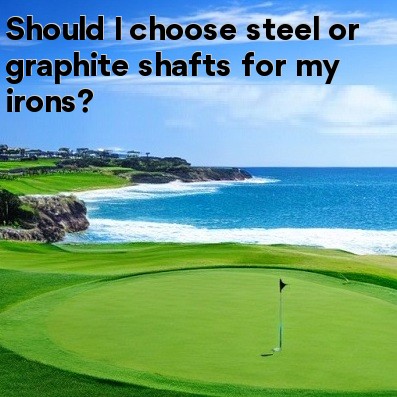
Should I choose steel or graphite shafts for my irons?
Golfers have a lot of decisions to make when it comes to their equipment, and one important choice is the type of shaft to use in their irons. There are two popular options: steel and graphite. Each has its own advantages and disadvantages, so it's crucial to consider your own playing style and preferences before making a decision.
- Steel shafts
Steel shafts have been the traditional choice for irons for many years, and they come with a number of benefits. One of the main advantages of steel shafts is their durability. They are incredibly sturdy and can withstand a lot of wear and tear, making them a great option for golfers who play frequently or have a more aggressive swing.
In addition to their durability, steel shafts offer excellent control and accuracy. They provide a consistent feel and feedback on every shot, allowing golfers to have better control over their ball flight. If you are a player who values precision and shot shaping, steel shafts might be the right choice for you.
On the other hand, steel shafts can be less forgiving. They tend to be heavier than graphite shafts, which means they require more strength and clubhead speed to generate distance. Golfers with slower swing speeds or those seeking extra distance may find that graphite shafts suit their needs better.
- Graphite shafts
Graphite shafts have gained popularity in recent years, and many professional golfers now choose them for their irons. One of the main advantages of graphite shafts is their lightweight nature. They are significantly lighter than steel shafts, allowing golfers to generate higher clubhead speeds and maximize distance.
Another advantage of graphite shafts is their vibration dampening properties. They help reduce the shock and vibrations that travel from the clubhead to the hands, resulting in a smoother feel. This can be especially beneficial for golfers with joint or hand issues or those who prefer a softer feel.
However, graphite shafts may not provide the same level of accuracy and control as steel shafts. They can feel less stable and provide less feedback on mishits, making it harder to consistently shape shots. Players who rely heavily on shot shaping and control might prefer the precision offered by steel shafts.
- Making a decision
When it comes to choosing between steel and graphite shafts for your irons, it ultimately depends on your individual preferences and playing style. If you prioritize durability, accuracy, and shot shaping, steel shafts might be the best option for you. However, if you value distance, forgiveness, and a smoother feel, graphite shafts may be more suitable.
It's also worth noting that there are different flex options available for both steel and graphite shafts. The flex refers to the ability of the shaft to bend during the swing, and it can significantly impact your performance. Make sure to consider the flex that aligns with your swing speed and playing style when choosing your shafts.
Lastly, it's always a good idea to visit a professional club fitter or golf store to try out different shaft options and get custom fitting. They can analyze your swing and help you make an informed decision based on your unique needs and goals.
Ultimately, the choice between steel and graphite shafts for your irons is a personal one. Consider your playing style, swing speed, and preferences before making a decision, and don't be afraid to seek professional advice. The right choice can make a significant difference in your performance on the golf course.





